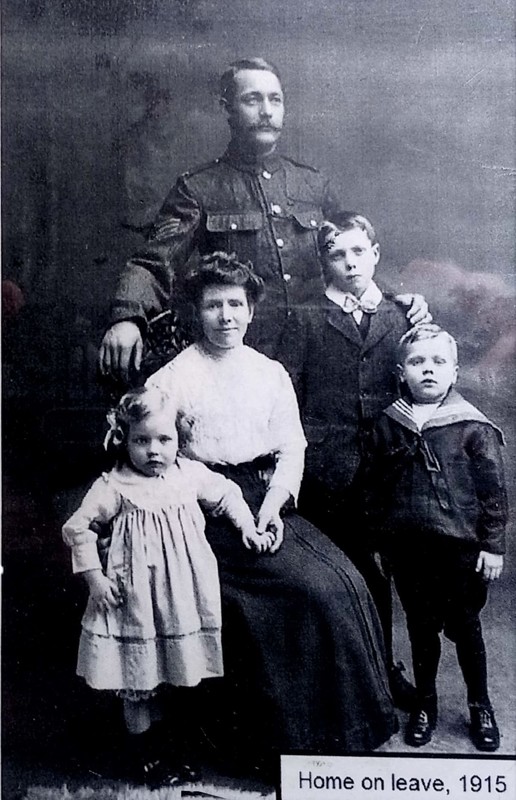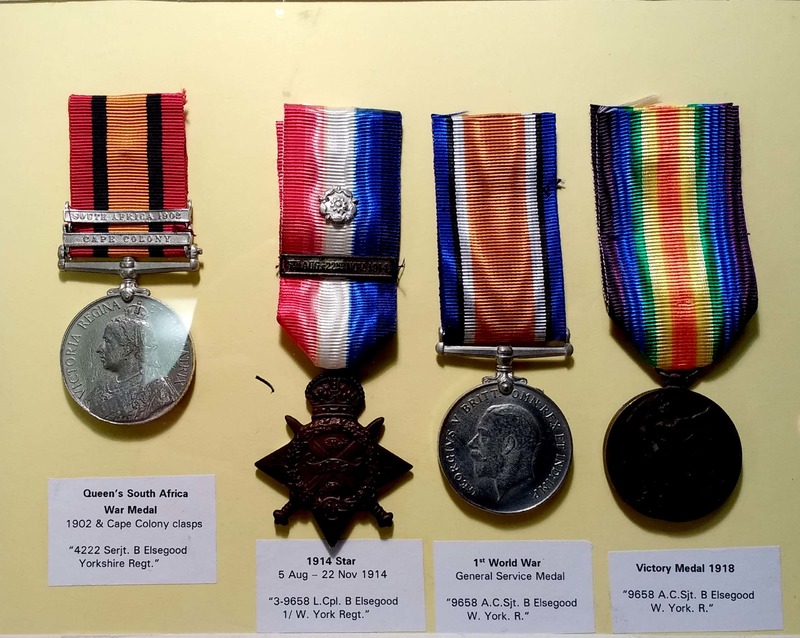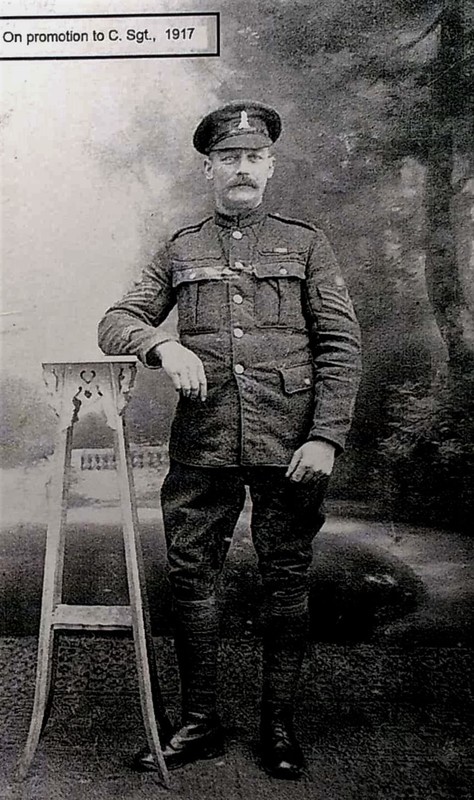L/Cpl Benjamin Elsegood (photographs; medals)
Item
Title
L/Cpl Benjamin Elsegood (photographs; medals)
Who?
L/Cpl Benjamin Elsegood
Item(s)
Personal photos and medals from Boer War and WWI. Citation on reverse of medal frame donated to The Yorkshire Regiment Museum, York.
Story
Benjamin Elsegood was born in Brome, Suffolk, on 21 October 1879, the fifth child and youngest son of Jabez Elsegood and Emma Jane Stannard. Jabez Elsegood was a Gardener and, in slack times, an Agricultural Labourer and his children followed.
At the age of 12, Ben followed his elder brothers who had moved to find better conditions of employment in York, using the newly opened railway link from Bury St. Edmunds. Ben arrived in York with two pennies in his pocket, not enough for the tram journey to the house where his brothers were living, so he was told to follow the tram lines from York Station and then follow the right fork after the river, to his destination (off Fulford Road).
The story (unverifiable) goes that Ben joined up for the Army before he was eligible: he obtained or forged a document to misrepresent his age, and joined the Yorkshire Regiment (The Prince of Wales Own, and formerly the 14th Regiment of Foot). At the outbreak of the South African War in 1899, he would be 19 years of age. He was awarded the Queen’s South Africa Medal with two clasps (“Cape Colony” and “South Africa 1902”). On discharge, he returned home to York, married Sarah Jane Caven and commenced work as a Gardener.
On the morning of the 4th August 1914, Germany declared war on Belgium, and two of her cavalry divisions passed the frontier: in the same afternoon, infantry columns also entered Belgium. Ben Elsegood, having served in South Africa, was a member of the Army Reserve, and was called-up immediately to report for training and potential mobilization. He was 34 years of age and already an experienced Infantry soldier. Ben re-enlisted in the 3rd Battalion, 1st West Yorkshire Regiment (hence his regimental no., 3-9658) and his service from re-enlistment is dated from 30 August 1914. On 17 September 1914 he was appointed L/Cpl and remained in the UK (either re-training or assisting with the re-enlistments) until 7 October 1914 when he was posted to the 1st Battalion (already in France, part of III Corps and the 18th Infantry Brigade).
By the time Ben and his colleagues arrived in France on 10 October, the Battle of The Aisne was locked in stalemate, and both sides had begun what was called “The race to the sea.” The 1st Bttn (part of III Corps) was formed up at Hazebrouck, comprising the troops who had moved north from The Aisne and those (including Ben) joining from the UK, and advanced to the German lines east of Hazebrouck on 13 October 1014. 18th Infantry Bde., including 1st W. Yorks encountered the Germans entrenched between the villages of Méteren and Vieux Berquin.
III Corps took heavy casualties (708 losses) during that first encounter, but in subsequent days pushed back the Germans to a line east of Armentières (part of the First Battle of Ypres) which allied forces then held until March 1918. For most of the bitter, harsh winter of 1914-15, Ben was fighting in the trenches in the Houpelines Sector, on the Yser Canal and The Canal Bank in Ypres. The Commanding Officer, Lt. Col. Huffan, records that “From January to May 1915, the Battalion was in every trench from Chapelle D’Armentières to Le Touquet; and although there was no fighting, the wastage from sniping and sickness was great.” He also notes that the Royal Engineers were not in a position to assist with material for better trenching, and it is clear from the tone of his diary that this was a period of unmitigated misery. Ben was injured during this time, promoted to Sergeant on 7 April 1915 and repatriated to the UK for recovery, during which period he worked in the factory of Herbert Morris Engineering Ltd. at Loughborough until assessed fit to return to the front. He rejoined 1st Bttn., newly redeployed on The Somme front, for the attack on Trones Wood on 1 October 1916.
In the autumn and winter of 1916 and until September 1917, Ben was in action east of Arras with 1st Bttn., between Ville sur Ancre (near Albert) and Cambrin (north of Arras), then in action at Loos between May and July 1917. On 18 September 1917, approaching his 38th birthday, Ben was transferred to 109 Company of The Labour Corps still in the rank of Sergeant and (it must be presumed) still in support of 1st Bttn. W. Yorks Regt., until his promotion to Company QuarterMaster Sergeant on 6 April 1918. He was demobilized and transferred to Army Reserve with effect from 1 March 1919.
In civilian life after the war, he worked as a Traction Engine Driver for James Bowman Removals in York, and as Steamroller Driver/Foreman of a roadlaying gang for York Corporation. He was “as hard as nails”, and lived to the age of 84. He passed away on 8 Feb 1964.
As his eldest grandson, I am privileged to have accompanied him to Remembrance Parades and The Armistice Day ceremonies at the South African War memorial and the WW1 Memorial in York when I was aged between 13 and 17. I have prepared this frame and replicas of his medals (I retain the originals, his stripes and his lapel badges) and am pleased to donate it in his honour to the Yorkshire Regiment Museum.
Written by Alan D Elsegood, 14/11/2015
At the age of 12, Ben followed his elder brothers who had moved to find better conditions of employment in York, using the newly opened railway link from Bury St. Edmunds. Ben arrived in York with two pennies in his pocket, not enough for the tram journey to the house where his brothers were living, so he was told to follow the tram lines from York Station and then follow the right fork after the river, to his destination (off Fulford Road).
The story (unverifiable) goes that Ben joined up for the Army before he was eligible: he obtained or forged a document to misrepresent his age, and joined the Yorkshire Regiment (The Prince of Wales Own, and formerly the 14th Regiment of Foot). At the outbreak of the South African War in 1899, he would be 19 years of age. He was awarded the Queen’s South Africa Medal with two clasps (“Cape Colony” and “South Africa 1902”). On discharge, he returned home to York, married Sarah Jane Caven and commenced work as a Gardener.
On the morning of the 4th August 1914, Germany declared war on Belgium, and two of her cavalry divisions passed the frontier: in the same afternoon, infantry columns also entered Belgium. Ben Elsegood, having served in South Africa, was a member of the Army Reserve, and was called-up immediately to report for training and potential mobilization. He was 34 years of age and already an experienced Infantry soldier. Ben re-enlisted in the 3rd Battalion, 1st West Yorkshire Regiment (hence his regimental no., 3-9658) and his service from re-enlistment is dated from 30 August 1914. On 17 September 1914 he was appointed L/Cpl and remained in the UK (either re-training or assisting with the re-enlistments) until 7 October 1914 when he was posted to the 1st Battalion (already in France, part of III Corps and the 18th Infantry Brigade).
By the time Ben and his colleagues arrived in France on 10 October, the Battle of The Aisne was locked in stalemate, and both sides had begun what was called “The race to the sea.” The 1st Bttn (part of III Corps) was formed up at Hazebrouck, comprising the troops who had moved north from The Aisne and those (including Ben) joining from the UK, and advanced to the German lines east of Hazebrouck on 13 October 1014. 18th Infantry Bde., including 1st W. Yorks encountered the Germans entrenched between the villages of Méteren and Vieux Berquin.
III Corps took heavy casualties (708 losses) during that first encounter, but in subsequent days pushed back the Germans to a line east of Armentières (part of the First Battle of Ypres) which allied forces then held until March 1918. For most of the bitter, harsh winter of 1914-15, Ben was fighting in the trenches in the Houpelines Sector, on the Yser Canal and The Canal Bank in Ypres. The Commanding Officer, Lt. Col. Huffan, records that “From January to May 1915, the Battalion was in every trench from Chapelle D’Armentières to Le Touquet; and although there was no fighting, the wastage from sniping and sickness was great.” He also notes that the Royal Engineers were not in a position to assist with material for better trenching, and it is clear from the tone of his diary that this was a period of unmitigated misery. Ben was injured during this time, promoted to Sergeant on 7 April 1915 and repatriated to the UK for recovery, during which period he worked in the factory of Herbert Morris Engineering Ltd. at Loughborough until assessed fit to return to the front. He rejoined 1st Bttn., newly redeployed on The Somme front, for the attack on Trones Wood on 1 October 1916.
In the autumn and winter of 1916 and until September 1917, Ben was in action east of Arras with 1st Bttn., between Ville sur Ancre (near Albert) and Cambrin (north of Arras), then in action at Loos between May and July 1917. On 18 September 1917, approaching his 38th birthday, Ben was transferred to 109 Company of The Labour Corps still in the rank of Sergeant and (it must be presumed) still in support of 1st Bttn. W. Yorks Regt., until his promotion to Company QuarterMaster Sergeant on 6 April 1918. He was demobilized and transferred to Army Reserve with effect from 1 March 1919.
In civilian life after the war, he worked as a Traction Engine Driver for James Bowman Removals in York, and as Steamroller Driver/Foreman of a roadlaying gang for York Corporation. He was “as hard as nails”, and lived to the age of 84. He passed away on 8 Feb 1964.
As his eldest grandson, I am privileged to have accompanied him to Remembrance Parades and The Armistice Day ceremonies at the South African War memorial and the WW1 Memorial in York when I was aged between 13 and 17. I have prepared this frame and replicas of his medals (I retain the originals, his stripes and his lapel badges) and am pleased to donate it in his honour to the Yorkshire Regiment Museum.
Written by Alan D Elsegood, 14/11/2015
When?
1914-1919
Where?
The Western Front
Contributor
Alan Elsegood, grandson
Collection Day
November 3 2018 Menston
This item was submitted on February 6, 2019




